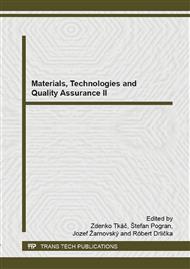p.67
p.75
p.83
p.91
p.99
p.105
p.111
p.119
p.127
Influencing of Combustion Ecology of Diesel Engines by their Intake Resistance
Abstract:
As it is generally known, diesel engines operate with air excess, i.e. lean mixtures. Intake resistances in intake manifolds of diesel engines negatively influence their ecological parameters. Based on these facts, we may conclude that less air in the intake manifold causes increased production of exhaust fumes and fuel consumption. One of the reasons of increased intake resistance is a blocked air filter. In the experiment, we have simulated the increased intake resistance and wished to point out possible consequences of pressure drop at the end of the compression stroke. The choking effect was realized by means of a throttle and scale, which was mounted on the air filter position. By using the dynamic method and obtained results, we found that choking at the rotation angle of 90° and 45° caused the difference of 0.16 MPa of the measured quantity during the maximum revs set on 2000 min-1. The difference in pressure at the end of the compression stroke with the rotation angle of 30° and 90° was by 0.86 MPa higher. Pressure drop in manifold showed the value 0.15 MPa. Manufacturers recommend regular replacement of air cleaners of combustion engines in service intervals; however, we must also keep in mind the environment in which the engine operates. In excessively dusty and otherwise polluted areas, it is necessary to replace cleaners a bit earlier.
Info:
Periodical:
Pages:
105-110
Citation:
Online since:
December 2014
Authors:
Price:
Сopyright:
© 2014 Trans Tech Publications Ltd. All Rights Reserved
Share:
Citation:


